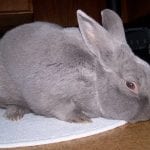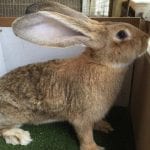Scientific Facts
| Common Name: | Dwarf Hotot |
| Scientific Name: | Oryctolagus cuniculus |
| Life Span: | 7 to 10 years |
| Size (Adult): | Dwarf |
| Weight (Adult) | 2.5 to 3.5 pounds |
| Habitat: | Human homes |
| Body Shape: | Compact |
| Country of Origin: | Germany |
Physical Description
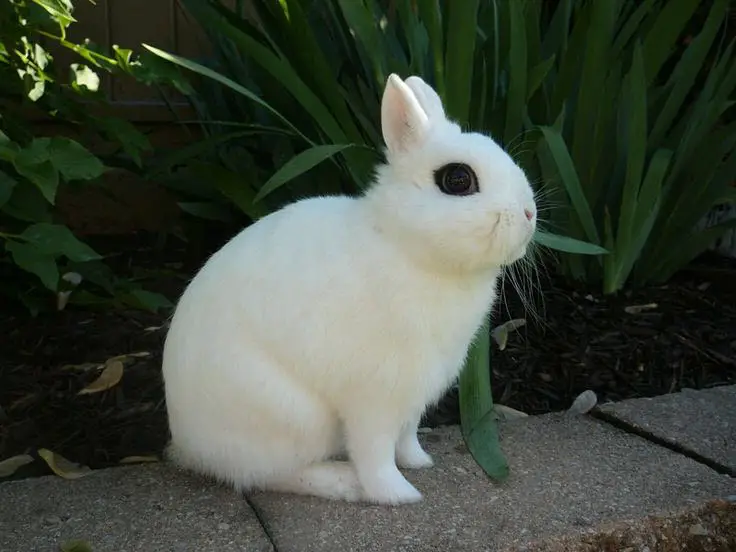
One of the most recently accepted breed in the American Rabbit Breeders Association or ARBA is the Dwarf Hotot. It is an unusual-looking rabbit with looks worthy of the show. It is small, compact, with lovely dense fur and with prominent dark eyes.
The Dwarf Hotot is a small breed of rabbits that weigh just between 2.5 to 3.5 pounds as an adult. These rabbits have white coats, small cute ears, and impressive eyes with dark markings. This rabbit has a compact body size, with a round and well-filled head and a very short neck.
According to breed statistics, the Dwarf Hotot must have rounded hindquarters, which must be in-line with their wide shoulders. The ears are thick and short. And this rabbit is not just about looks. It also has a warm and friendly personality and is definitely good as a first-time pet.
History of the Breed

The Dwarf Hotot was accepted by ARBA in 1983, and now, it has a very strong following. But contrary to speculations that it was from the breed of larger Hotots, this dwarf rabbit, it was actually developed from a normal-sized Hotot.
The original breed of Hotot was created in France at the start of the 20th century by Baroness Bernard. The dwarf was from combining the genes of the East and West Germany breeds in the 1970s. Two breeders bred the same rabbit independently and crossed the two specimens. The two breeders used the White Hotot and a Netherland Dwarf to develop the Dwarf Hotot.
It was only in 1970 when Elizabeth Forstinger from California brought 7 Dwarf Hotots from West Germany to the US. She began showing the cute rabbits in 1980. After two years of admiration, the American Dwarf Hotot Rabbit Club was launched.
The Dwarf Hotot was recognized by the ARBA in 1983 and still remains as one of the oddest but cutest rabbit breeds.
Many years have passed since it was recognized by the ARBA, the only accepted Dwarf Hotot varieties are the one with black eye bands. In 2006, the chocolate-banded Dwarf Hotot was accepted by the ARBA. In shows, the black and the chocolate-banded Dwarf Hotots are presented side by side with their eye band colors specified in the rabbit’s registration forms.
In the process of being approved are blue-eye band Dwarf Hotots. This breed is too small for the commercial rabbit industry and hence is only a fancy breed of rabbits.
Fast Facts
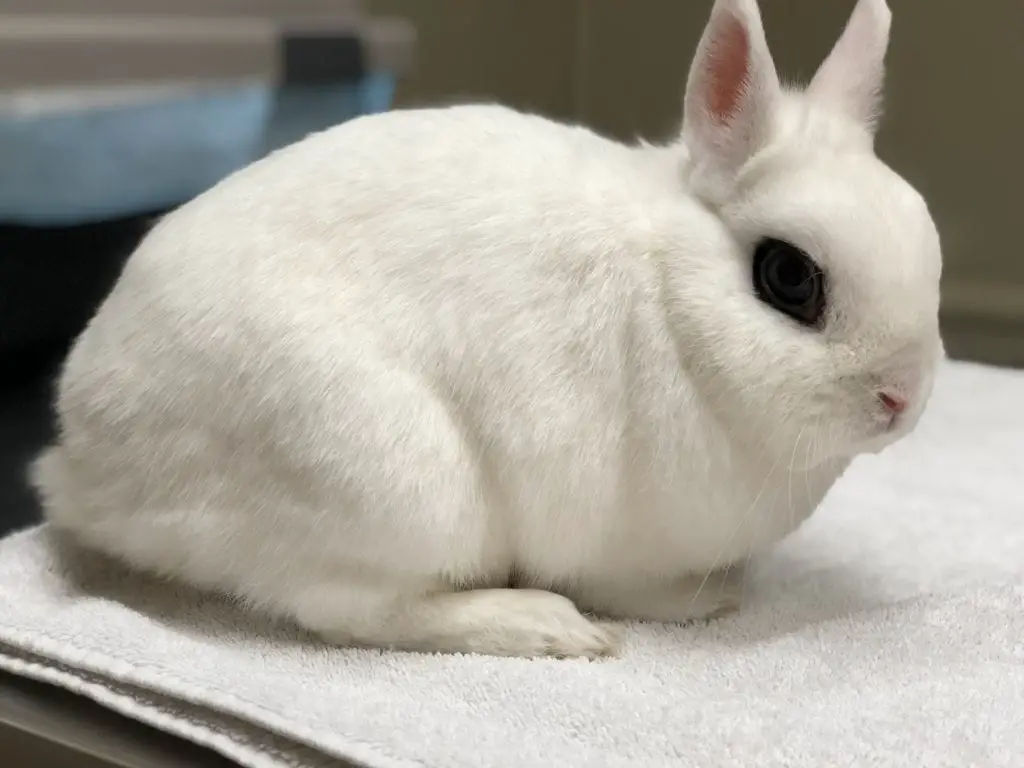
The Dwarf Hotot is known as a show-worthy breed because of their unique appearance. This rabbit is covered by a thick, velvety white coat from head to toe. And possibly the most striking feature of all is their large eyes with a black ring around it. This feature has earned its nickname “eyes of the fancy.”
Coat
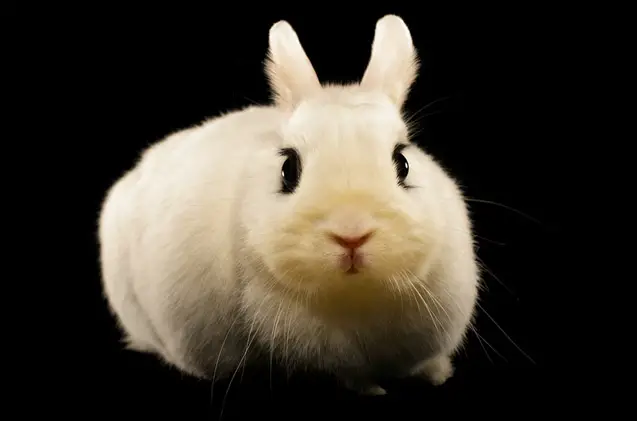
The Dwarf Hotot coat is short, shiny, and very dense. It has a rollback for which means that the strands will always stay upright even when stroked. Because the coat is dense and thick, it does not require much attention. And due to its size, you may not notice that it is molting. This happens in spring as animals shed their old fur to make way for new growth. More information about molting and grooming a Dwarf Hotot in a later section.
Colors
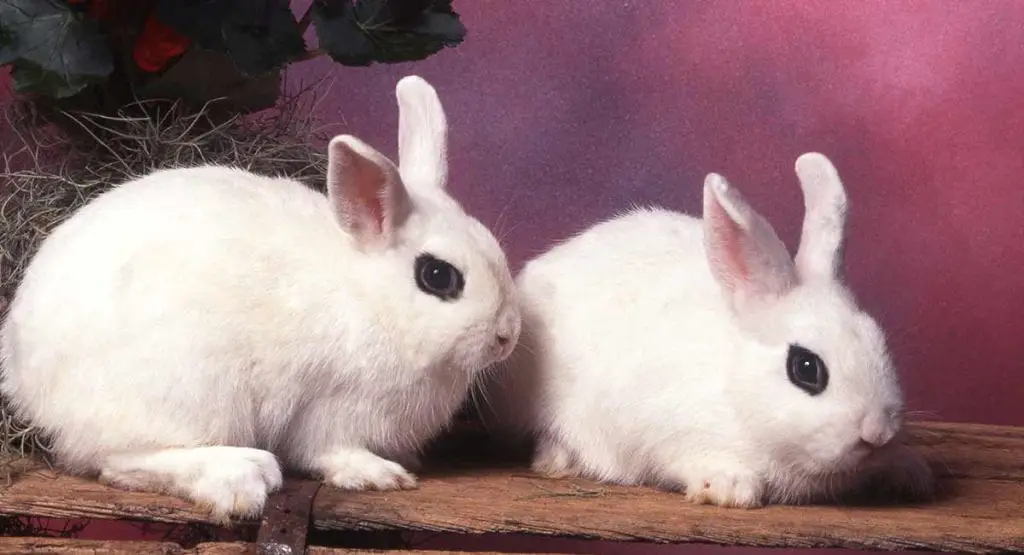
The Dwarf Hotot color combination accepted by the ARBA is the white with a black eyering that looks like an eyeliner. The black band around the eyes must not be too thin or very thick. The eye band must have a feathered appearance and should be at least 1/8 of an inch thick.
ARBA has recently accepted the white with chocolate brown eye band and soon, the white with a blue eye band color.
These are requirements for show rabbits. A pet may not have the characteristics mentioned here, but nonetheless, the Dwarf Hotot is still a pure breed. Some Dwarf Hotot specimens may not have a white coat. Some Dutch-marked or English-spotted kits may also be seen in a litter. This is not unusual. However, these rabbits may not be used for show or in competitions but make great pets.
Reproduction

Almost all rabbit breeds follow a certain pattern when breeding and mating are concerned, and Dwarf Hotots are no exception. Breeders usually set the mood for the mating process. The male has his own cage, and the female is introduced. This is done to increase the success of breeding.
As soon as the two are introduced, the male will start smelling the female as she stands motionless. If she has grown tired of his behavior, she will run around to escape. The buck will follow her and will try to mount her, usually performing thrusting movements.
The female may give in by lying still, or she will continue with the chase. Usually, when the female lies down, the male will immediately try to mate. If mating is successful, the male will thump his hind feet.
After just a few weeks, the female will be ready to deliver her kits. She will now look for a suitable nest that’s warm and safe. In the case of rabbits that are bred in captivity, the breeder places a nesting box, which is a simple box made of wood or cardboard stuffed with hay. The female will improve this design by carefully arranging the strands of hay and possibly adding her fur to keep the nest warm. The male is removed from the nesting cage before the female makes the nest.
You will notice that the female is ready to give birth when she appears to be uneasy and does not eat or drink. She will settle in the nest to give birth; usually, the kits are born several minutes apart. She will give birth from 3 to 5 babies.
The babies are born blind, naked, and deaf. These are vulnerable to predators, and sometimes, the female may eat any tissue or blood to avoid predators from smelling them. Any stillborn or dead kit may be eaten as well.
The babies will be nursed but only for a short while. The mother won’t return to her nest until nighttime when she nurses her babies. She may cover them with hay or any suitable material to keep them quiet, warm, and safe during the daytime.
The babies will open their eyes after 5 to 7 days and will leave the nest on the 10th day or earlier. The babies will wean from their mother’s milk and will be ready to eat other available food sources. The female rabbit will be ready to become pregnant again after she delivers. In some rabbits, the does will be ready to become pregnant right after she delivers. Juveniles will be ready to mate in just a few months.
Fun Facts
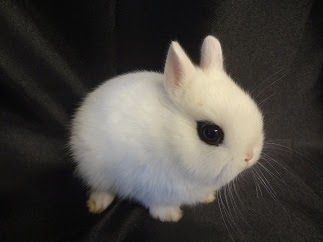
The Dwarf Hotot may look like the typical storybook rabbit, and this may be the reason why children love them. These photogenic bunnies actually have regular size eyes. The black or dark eyeliner simply makes them larger than what they are.
Personality and behavior

This breed is friendly and, therefore, well-suited as a pet. This is, of course, possible if it gets a lot of human interaction and gets to live with other rabbits in a cage. Companionship is important in the life of rabbits, whether these live in the wild or human homes.
The Dwarf Hotot will love to be out of their cage, playing, running, and even wrestling with their siblings. You can use this energy by training them to come to you and to perform some tricks. Use food or treats as a way to make them obey you. Sometimes, a rabbit may not follow through though but don’t worry because it will soon learn to trust you and then warm up to you as well.
Routines are important with this breed. You must follow a schedule such as early morning feedings, potty training after and then let them loose in your yard or home. But before you do, make sure that the arear has been rabbit-proofed.
Just like any rabbit breed, the Dwarf Hotot will love to chew on wood, wire, and screens. You won’t be able to train them to heel; therefore, it’s up to you to remove these items before you let them loose.
Some Dwarf Hotots, especially adults, simply prefer to sit and eat hay. They won’t mind young rabbits playing about and won’t be aggressive even when the bunch becomes rowdy.
This rabbit is not aggressive towards other rabbits and won’t be territorial. But some breeders say that any rabbit can develop a territorial attitude when it is kept in a very small cage together with other males. The males will try to compete for space and territory, and this may result in fights, blood, and sometimes death.
Some experts say that a Dwarf Hotot doe may eat her babies. If you see this, remove the female and never allow this to breed again. But some say that this is a defense mechanism to remove all blood, smell, and tissue in the nest to protect her litter from predators.
Mating behaviors are also noticeable, and sometimes, this can turn to aggression as the male wants to mate with a non-receptive female. Breeders usually separate the two once this happens and then try again after a few hours to days.
Dwarf Hotots can live with other rabbits of the same species. It is comfortable inside a home and will also be friendly with your other pets.
Care of Dwarf Hotots
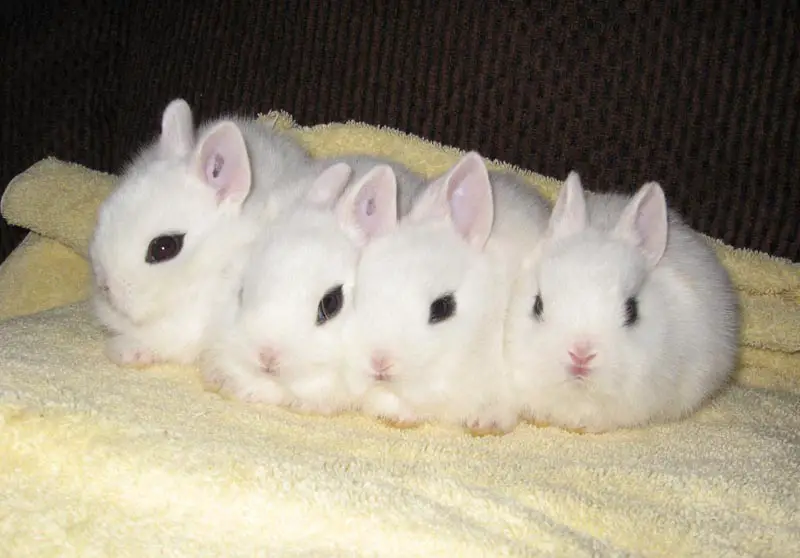
Caring for a pet Dwarf Hotot is the same as how you care for other breeds. To keep your pet healthy and happy, give it the correct diet, housing, companionship, and take it to a vet for medical treatment and illness prevention.
The main food of captive rabbits is hay. Hay is a staple of all rabbit diets, but you may also feed them pellets for rabbits. Commercially-prepared food has added vitamins and minerals for improved health. You may add vegetables and fruits for a healthy rabbit diet.
Give your pets unlimited fresh water and hay. Hay will keep their digestive tracts healthy and regular. Water should be placed in a heavy shallow dish so that your rabbit can drink from it. A heavy dish is important, so your rabbit won’t knock it over inside the cage. You may also place water in an inverted bottle. Your rabbit will just sip water from here.
Feed only natural, organic food to protect your rabbit from pesticides, toxins, and herbicides. Give younger rabbits alfalfa hay because this is rich in calcium for growing bones. The adult Dwarf Hotots will eat legume hay because this helps them with digestion.
Dwarf Hotots can become a loving, sweet pet, but you need to train it well. Interact with your pet by playing with it daily. Rabbits are social and will need a companion. Experts say that captive-bred rabbits thrive well because they have cage mates and their owners to interact with every day.
Dwarf Hotots are experts when it comes to grooming themselves. Sometimes a rabbit with this type of fur can take hours cleaning itself, taking extra time cleaning under the feet and ears. Rabbits may also be seen grooming each other as social behavior. Mother rabbits may also groom their young by licking their fur and removing dirt and grime. This is done while she’s feeding.
Dwarf Hotots are active during the day and thus will sleep in the evenings. Their feedings must be given in the morning because this is when the rabbits are active and energetic. Captive rabbits sleep 8 hours a day, on average, and usually, these sleep huddled together to keep warm.
Supplies and Cages
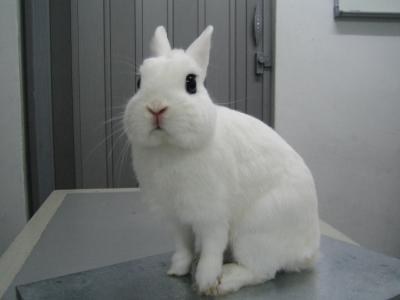
The cage for captive Dwarf Hotots should be made of wire and must have a strong frame. Don’t underestimate the size of a Dwarf Hotot because it can easily escape if you’re not careful. The bottom must have a removable pan or tray where the rabbit’s droppings will fall. You can easily maintain this during clean-up time. Also, the floor of the cage must have soft bedding so that it is comfortable for your rabbit to stay on.
The good idea is to place a hay feeder on the side of the enclosure. This must always be filled with hay so your rabbit can eat this when they feel hungry. For bedding, use hay or aspen, wood pellets, or other comfortable, easy to use bedding material.
Clean the cage by first removing your pet/pets. Hose the cage down and clean it with a safe cleaner or natural cleaning product such as white vinegar, baking soda, or lemon juice. Do not use common household cleaners, which may have toxic ingredients that are dangerous to your rabbit’s health.
Take note that baby Dwarf Hotots are born without fur and with their eyes closed. To breed rabbits, have an enclosure for your baby rabbits. put the babies in a warm enclosure or container to keep their bodies at the best temperatures. A large container or enclosure is nicer and more comfortable than a small one. Place a lot of hay to keep temperatures warm and waterproof.
Just like other rabbit breeds, Dwarf Hotots love chewing on things. If kept indoors, these will chew on anything made of wood, such as walls, fixtures, and furniture. Rabbits are very curious and may even chew on electrical wiring. To avoid accidents, place hay, or chew toys inside the cage. Rabbit proof your home too if you plan to let your rabbits roam free inside your home.
Health Concerns
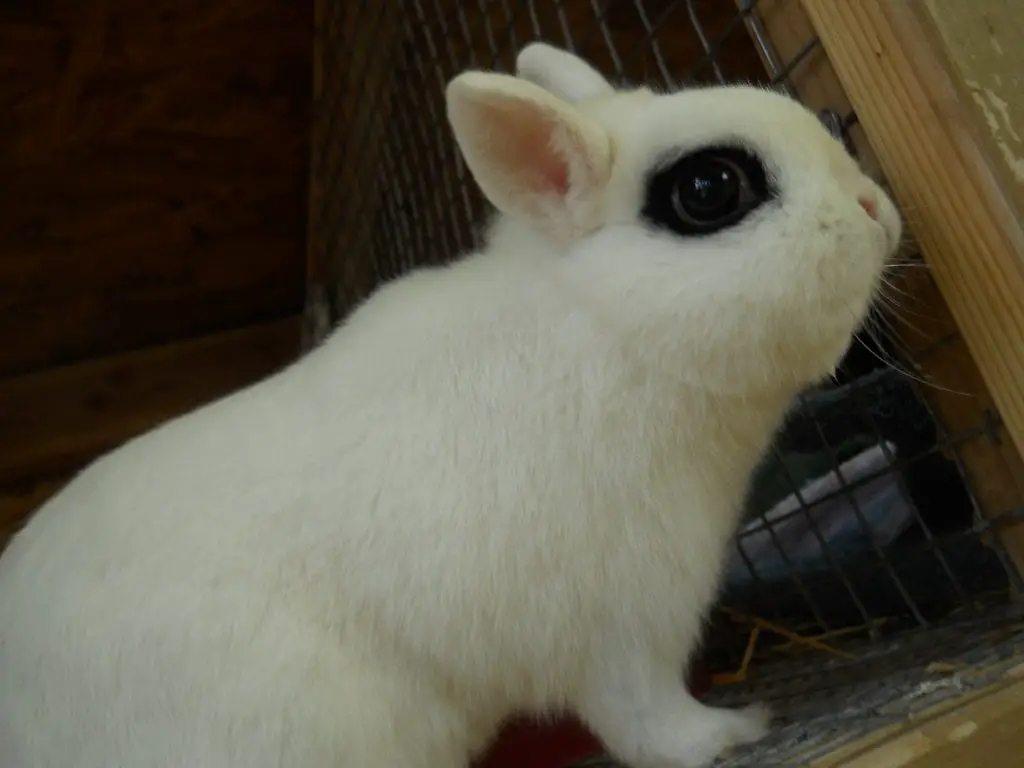
Dwarf Hotot is known to be a healthy breed and does not have a specific breed disease. Possibly the most that Dwarf Hotots may be affected with are pests such as mites, ticks, and fleas because these are pests that are naturally found in their environment. Remove theses by applying pest powder or natural pest control oils.
Also, remember that captive rabbits are not immune to common rabbit diseases; therefore, you must always be aware of your pet’s health and temperament. Any change can be due to an illness. So as early as your pet can walk and leave the nest, take it to the vet for vaccinations and tests.
The vet will assess the health and development of your pet. Also, there are rabbits with sensitive digestive systems and thus could be prone to many health conditions of the digestive tract, including enteritis, bloat, and stasis. These may affect rabbits that are around two months old or younger.
Also, check for ear or fur parasites such as mites, fleas, and ticks. Usually, rabbits with these pests lack hygiene and live in untidy surroundings and cages. So clean your pet’s cage regularly to avoid these menacing pests.
You must learn to assess your pet for any signs of illness like lack of appetite, poor energy, nasal and eye discharges, diarrhea, and vomiting. Check for unsteady gait, restlessness, a grating of the teeth, and sleeping for longer hours may be signs of a serious condition.
De-worming is also important in Dwarf Hotots as well as other breeds. This is a major concern with rabbits that are from the wild or are born from wild parents. All rabbit breeds should receive proper deworming, and this should be done during the spring and fall seasons.
Don’t use tablets or liquid deworming medications. Use only a pea-sized amount of de-worming paste because this is easier to apply. Just put it in the rabbit’s mouth. It will continuously lick it and swallow the formula. You may need to repeat this according to your vet. Also, follow the dose according to the product packaging for the best results.
Dental Care
A Dwarf Hotot is known for growing its teeth, and sometimes its teeth can grow very fast. As an owner, make sure that the rabbit’s teeth don’t overgrow. When this happens, their teeth can grow into their mouths and jaws, which cause terrible pain and will also affect the way they eat.
You can help your rabbit by giving it hay as it files down the rabbit’s teeth naturally while they chew. Use small pieces of wood, old wooden baskets, or other cage accessories to file the rabbit’s teeth. Always keep an eye on your rabbit’s dental health, so you can save on expensive medical and dental bills.
Spaying or Neutering
Because of the promiscuity of rabbits, you must control their capacity to breed, especially if you want to keep more of these rabbits as pets. Spaying and neutering should be done at a young age. And while some vets do this, some also wait until the rabbits are six months old to be on the safe side.
Dwarf Hotot bucks are also neutered at a young age because it is said that neutering prevents aggression. Some bucks may be neutered as young as three months! It’s best to consult a vet for the best practices for spaying and neutering and to ask about post-surgical care of your pet.
Grooming
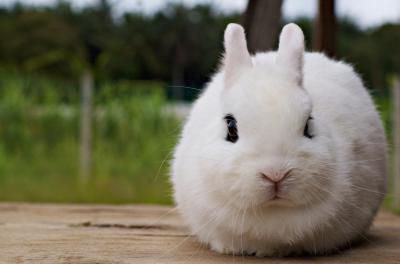
Dwarf Hotots have short to medium fur; therefore, it ill need regular grooming. Brush the fur to keep it clean, shiny and free from mites and pests. You must groom it using a small brush weekly.
You must groom more frequently during their molting period. This is the time when your pet sheds its fur to make way for new fur. Grooming at this time will prevent wool blocks and will prevent the rabbit from ingesting their fur. This can accumulate in the digestive tract causing blockage and more complications.
Even if your rabbit is very dirty, never give it a bath because doing so can lead to stress. You may use a damp towel to spot clean your pet and simply wipe the rabbit down with the towel. Use a dry towel to dry it off completely.
Another important part of grooming is trimming the rabbit’s nails monthly. Also, check its mouth for overgrown teeth. You may ask the vet to do this for you if you don’t have the tools to cut its nails or check its mouth. Finally, the rabbit’s big ears must be cleaned and checked.
Comparable Breeds
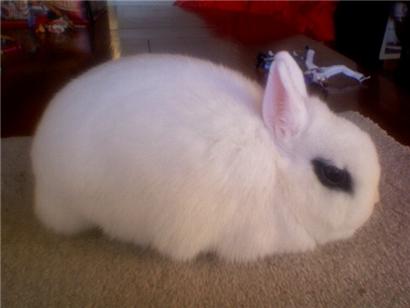
The Dwarf Hotot is comparable with a few rabbit breeds, and one of these is the Blanc de Hotot Rabbit. The Dwarf Hotot may have Blanc de Hotot’s looks, especially the prominent eyes, but the Blanc de Hotot is a large species weighing around 8 to 11 pounds. This rabbit can live up to 10 years and is a commercial rabbit suitable for singles and families with children because of its warm, sweet, and active nature.
Another breed that’s comparable with the Dwarf Hotot is the Netherland Dwarf Rabbit. The two have almost the same size, but the Netherland Dwarf is smaller, weighing only 1.1 to 2.5 pounds. This is a hardy breed, though, and can live up to 12 years. It has a compact size and is quiet, skittish, but its sweet personality will shine after regular human interaction. The Netherland Dwarf is suitable for singles, families, and seniors.
Availability – Where to Get One?
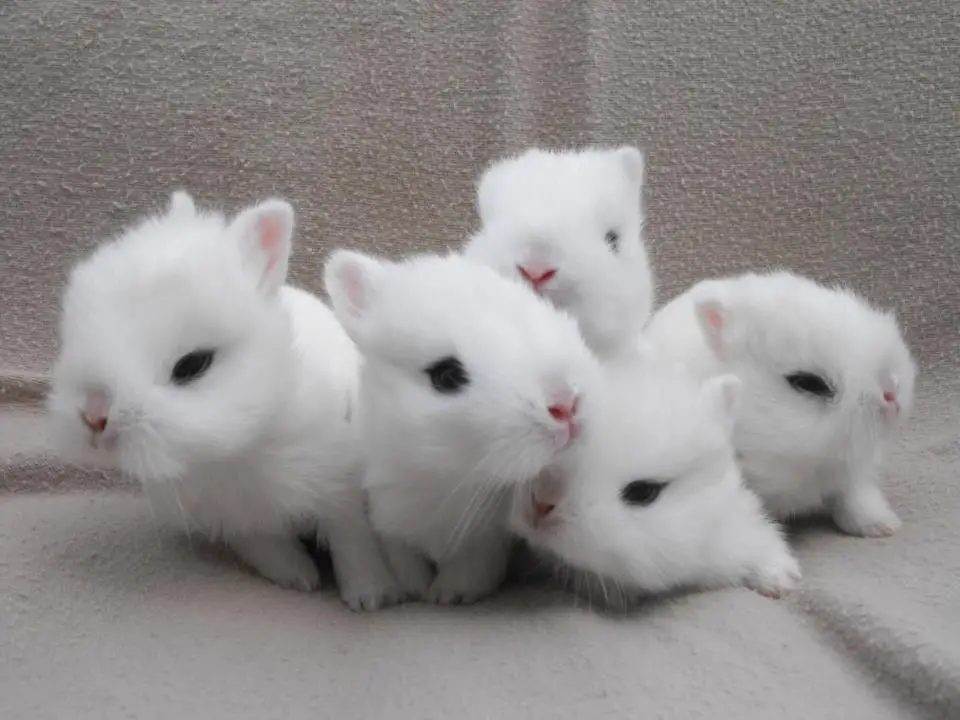
The cost of a Dwarf Hotot may depend on whether you are getting it from a breeder or a pet shop. The price varies also whether you are getting a rabbit as a pet or for show. Take note that the price ranges according to size, gender, eyeliner color, coat quality, and overall appearance.
If you’re looking for a reliable breeder, make sure that you are buying a rabbit that is healthy and free from any genetic disorder. You must buy only from reliable breeders who raise Dwarf Hotots. Dwarf Hotots may also be seen and purchased in trade fairs and farm events. ARBA-sponsored shows and contests may also feature this breed.
How to Care for a Dwarf Hotot
This is to summarize the care of a Dwarf Hotot. First of all, caring for this breed is just like caring for other rabbit breeds. You need to keep in mind important things like correct diet, housing, companionship, and take it to the vet for proper medical treatment.
The main food of captive-bred rabbits is hay. Rabbits can chew this all day long. You may also use pellets that are created for rabbits, vegetables, and for a well-rounded rabbit diet. You may also give rabbits grasses, twigs, maples, seeds, fruits, and weeds.
Keep fresh water and hay in the rabbit’s cage. Hay helps keep the digestive tracts of rabbits healthy and regular. Offer water in a large, heavy shallow dish so that your rabbit can drink from it, and this won’t knock it over as it moves in the cage.
Finally, keep in mind that Dwarf Hotots can become a good pet only when you invest time and effort to train it. It would help a lot if you train and interact with your pet on a daily basis. Rabbits are social animals and will need a few companions.
Therefore, don’t just get one or two rabbits, take care of three or more for healthy, happy, and well-rounded pets.
FAQ Section
Do Dwarf Hotots consume fruits and vegetables?
Yes, you can provide pet Dwarf Hotots some fruits and vegetables. Dwarf Hotots will also eat commercially-prepared pellets or rabbit food that contain nutrients that your pet will need daily.
What do Dwarf Hotots eat?
Dwarf Hotots are herbivorous, which means that they will eat only plants. They will eat plant parts like roots, bark, seeds, weeds, and leaves.
Can Dwarf Hotots swim?
Yes, Dwarf Hotots are also like other rabbits that can swim but not as good as water mammals. But you don’t want to get your pet because this can cause extreme stress.
How do you tame a rabbit?
Never pet or tame a wild rabbit because this won’t be trained and may even bite you if it thinks that you are a threat. You can train and pet a captive-bred rabbit instead. But although these rabbits are known for their docile behavior, these will still need constant handling, playing and activity with their handlers to remain receptive, docile and sweet.
Will Dwarf Hotots eat their poop?
Like other rabbits, Dwarf Hotots will eat their poop because these still have nutrients. But after eating the poop once, they won’t do it the second time. This behavior seems to be true to all breeds.
Can Dwarf Hotots eat meat?
No, these rabbits are herbivores, and this means that these won’t eat meat, only plants or plant parts. Dwarf Hotots will eat roots, bark, leaves, flowers, twigs, stems, seeds, and so many more.
How large should a Dwarf Hotot’s cage be?
One Dwarf Hotot should be kept in a very large enclosure because of its size. For two rabbits, double this area. You should make sure that your rabbits have enough space to play, eat, and sleep.
Are Dwarf Hotots territorial?
Dwarf Hotots are docile and non-aggressive, but it can be territorial when kept in a small enclosure. Males may also become very aggressive to other males during the breeding season. They may bite, scratch, and kick their rivals to establish some kind of hierarchy.
Will a mother, Dwarf Hotot, eat her young?
Some female rabbits will eat their young. And if you spot this behavior, remove it from the litter or nest and don’t let it breed again.
Can you prevent a Dwarf Hotot from eating his poop?
Yes, you can stop it from eating poop by removing the droppings as soon as you see them. But no matter what you do, these animals will still eat their poop because they understand that there are still nutrients in them.
Are Dwarf Hotots endangered rabbits
No, the Dwarf Hotot is not endangered, and in fact, this is available in trade shows, pet shops, and other retailers.
Where do Dwarf Hotots live?
You won’t find the Dwarf Hotot breed in the wild because these are domesticated rabbits and are mostly in homes, breeding kennels, pet stores, and more.
Can you keep two or more Dwarf Hotots inside a cage?
You can keep two or more rabbits in one cage, but the cage has to be large enough to keep all the rabbits in. Take note that the cage should be large, comfortable for your pet rabbits to remain in.
Should you pick up a wild rabbit from the forest?
No, don’t take a wild animal like a rabbit from the forest. Don’t attempt to do this because the rabbit may have rabies, and this can bite you. You may be better off with a captive-brought pet Dwarf Hotot.
Are rabbit diseases harmful to humans?
Yes, some rabbit diseases are dangerous to humans. However, some diseases are only dangerous to rabbits and other animals. Always take your pet to the vet for any signs of illness.
Can you keep a Dwarf Hotot as a pet?
Yes, you can keep a Dwarf Hotot as a pet because it has a docile and sweet temperament. It is a good pet for families but not for families with very small children.
Do you need to place a heater inside a Dwarf Hotot’s cage?
You may use a cage lamp to provide heat. In very cold weather, use a small portable heater and place this near the rabbit cage so you’ll have a comfortable place for your pet to live in. This is also important, especially for warming kits or bunnies.
How do you clean a Dwarf Hotot’s cage?
First, remove the rabbit and place it in another cage. Remove the pan for the droppings and dispose of the droppings carefully. Use a hose and cleaning products and clean the cage walls, bottom, accessories, and toys. Everything is dry before putting your pet back in.
What happens when the teeth of rabbits grow longer?
As the teeth of the rabbit become longer, these can pierce its mouth and lower gums and can cause a lot of pain and may affect its appetite as well. This is why your pet rabbit should visit the dentist. Also, offer a lot of hay for the rabbit to chew because hay can naturally grind their teeth.
How often do rabbits need to go to the vet?
Rabbits should visit the vet at least once a year. Young rabbits must receive vaccination against some diseases, so they need an initial visit to a vet during the first weeks of life.
Are Dwarf Hotots able to escape their cages?
Yes, Dwarf Hotots can escape their cages, but these can’t jump over their cages, but these are strong enough to kick their cages down. Large Dwarf Hotots can be very good kickers and will kick their cages or fences to escape, so don’t underestimate this breed.
Are Dwarf Hotots bites dangerous?
Yes, all rabbit bites are dangerous because these may have rabies. The rabbit teeth are huge, and this can easily tear off your skin and cause a deep wound.
Can rabbits see well in the dark?
Yes, rabbits with large, bright eyes have amazing vision, especially during nighttime. This is why some species want to forage for food at night. Rabbits have an impressive sense of smell and hearing to allow them to detect predators easily.
Do Dwarf Hotots have good hearing?
The Dwarf Hotot may have smaller ears than other rabbit breeds, but this rabbit has good hearing. It will be able to hear any threats from far away, and therefore, it still has time to jump and escape from danger.
How do you take care of baby Dwarf Hotots?
If you’re breeding Dwarf Hotots, place the babies in a comfortable and warm area. Feed babies soft pureed food and keep these very warm. Protect the bunnies from predators and even from pets like your common house cat or pet dog.
Can you leave a Dwarf Hotots indoors out of its cage?
Just like letting a rabbit stay outdoors out of its cage, you may let a rabbit stay indoors but under constant supervision. Use a portable perimeter fencing to fence-off areas that the rabbit is not allowed to go. You must rabbit-proof your home before you let your rabbits roam free.
Do you keep a Dwarf Hotot’s cage indoors or outdoors?
This will depend on the size of your area, but you can place the cage of your pet indoors to protect it from the elements. But most indoor cages are small and may not be enough for a Dwarf Hotot. When you use an outdoor cage, the rabbits may need to bear the cold but will have a large area to play and run.
Does it hurt when a Dwarf Hotot hits you with its hind legs?
Dwarf Hotots have very sharp claws even on the rabbit’s hind feet. Also, it can kick very hard with its hind feet, which can cause damage. The rabbit will only do this if it feels threatened.
Can rabbits survive the cold?
Yes, rabbits will be able to survive the cold and do so by foraging food that’s underneath the snow. Rabbits will be able to dig underneath snow and eat things like roots, shrubs, berries, and other edible food.
Can Dwarf Hotots remain outdoors?
A pet Dwarf Hotot may be allowed to stay outdoors, but you must rabbit-proof the area first. Use a perimeter fencing to limit the area where the rabbit will be able to play, run, and roam free. Bury the poles of the fence well to prevent the rabbit from escaping the fence.
